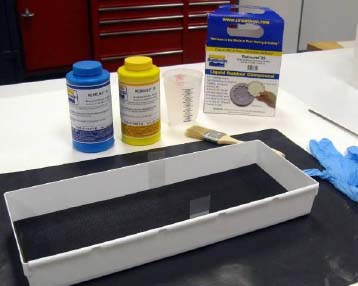
Topics in Photographic Preservation 2011, Volume 14, Article 40 (pp. 250-262)
Presented at the Library Collections Conservation Discussion Group, Book and Paper Group
session of the 2010 AIC Annual Meeting in Milwaukee, Wisconsin
This paper presents the development of an experimental conservation treatment system that replicates the patterns of original covering materials on bound volumes. The cast composite system has potential application in simple and complex treatments of bound volumes. The technique uses supplies widely used in book conservation and adapts surface casting methods common in objects and paintings conservation. Silicone molds are used to replicate the surface textures of original covering materials on bound objects. A blend of acrylic gel, additives, and paint media is specially formulated to retain the surface texture from the silicone mold. The textured cast is then used as a repair material either alone as a film or with supporting substrate(s) like paper, non-woven polyester, or textile. Features of the original materials can be matched by adjusting components of the cast composite system using the customization tips for replicating surface textures, original finish, opacity, and color. Cast composites are easy to create from affordable materials readily available from conservation and artist material suppliers. Completed cast composites are less invasive, thinner, and visually more compatible than bound volume repairs with new leather or Japanese papers.
Cast composites are a key component of an experimental conservation treatment system in development at the Barbara Goldsmith Conservation Laboratory of The New York Public Library. The system can produce repair materials that are suitable for bound volumes covered in almost any kind of textured material. Repairs made with the system incorporate supplies widely used in book conservation, adapting surface casting techniques common in objects and paintings conservation.
The methods and procedures for producing silicone rubber molds and cast composites are presented in conjunction with customization tips. Impressions are taken from surrogate material to make a mold that closely matches the original covering surface. The acrylic media are blended to reproduce the color, sheen, and opacity of the original covering, then cast on the textured mold. Layered application of the blend produces aesthetically superior repair materials. Cast films can be used alone or as composites with support substrates like paper, non-woven polyester, or textiles. Without a support layer, they can be used to fill abraded areas of a covering material. Cast films with supports can be used to repair joints, reattach boards, and fill losses. Substrates can be embedded into the acrylic blend directly during the casting on the mold or adhered later to the dried film.
As a repair material, cast composites can be used to compliment a variety of common book treatments. The advantages of the cast composite system include affordability, availability, low toxicity, and increased aesthetic matching of original covering materials. By modifying the components in the acrylic blend, the system can be utilized for a range of simple to complex treatments. Cast composites can be less invasive, thinner, and visually more compatible than traditional repair materials. The cast composite system can be scaled up or down to fit the needs of special or general collections.
There are many conservation techniques for addressing the physical damage often found in bound volumes, including: board reattachment with threaded tackets; long-fibered kozo paper or cotton-linen textile extended spine linings; rebackings with leather or textile; toned paper joints; or paper infills. Methods to maximize visual unity between repair and original materials include toning or dyeing repair components and inpainting.
Current conservation techniques for repairing damaged three-dimensional objects can be of limited use when applied to book conservation. Conservators routinely capture and replicate surface textures on three-dimensional objects, typically using a mold system (O’Donnell 1997, Nieuwenhuizen 1998, Sturge 2000, Kronthal et al 2003, Kite and Thomson 2006). The mold is then used to texture infill material placed in the lost area while soft. Textures can also be transferred to infills with heat. The fill material is often colored before and inpainted after the textured repair is in place. Heat application of a pattern to a mend on a book is difficult and often not possible in crowded shoulder joints and caps.
Texturing techniques described in other disciplines such as paintings and objects conservation have not been widely adopted by the book conservation community, in part due to concerns about physical compatibility and toxicity. Most of the objects treated in this manner are static. Bound materials differ from other kinds of three-dimensional artifacts because they are dynamic. The use of BEVA 371 resin solutions, advocated in the other disciplines for filling losses, requires solvent-extraction units to which many book conservators do not have routine access. BEVA film, which does not need solvents and can be heat activated, is difficult to incorporate into book conservation treatments because it can be hard to melt and color, and must be textured after application.
The historic bridge between conservation and bookbinding might have influenced the use of like materials: leather to repair leather covers, and cloth to repair cloth bindings. Using leather as a repair material is sympathetic to the original but is not always desirable because of concerns about cost of materials, the need for highly developed hand skills, and inherent vice. Toned paper repairs are a common and very useful technique for treating bound materials with lost or damaged leather (Etherington 1995), but there are drawbacks. Chief among these are problems of durability and aesthetic compatibility. More recent techniques that take advantage of the reactivation properties of certain acrylic adhesives such as Lascaux 498HV overcome some of the physical drawbacks to toned paper repairs, but still have dissimilar surface textures to the original covering material (Anderson and Puglia 2003).
In light of these issues, we have experimented with adapting the pattern-capturing techniques used by paintings and objects conservators, and incorporating them with common book repair methods into a cast composite system. “Cast composite“ is a term borrowed from materials science to describe a product composed of two or more substances of very different physical characteristics whose performance is significantly better than the performance of each substance individually. The result is a strong lightweight material with a custom-colored textured surface which can be used with supporting substrates as an alternative to leather or cloth for the repair of bound volumes.
For our technique, a silicone mold is created to bear the impression of the surface of a surrogate leather or textile. Acrylic paints are mixed to match the original color and sheen of the covering material, and then added to a combination of acrylic gel medium and additives. This formulation is spread onto the textured mold in at least two thin layers. Acrylic films can be reinforced with one or more supporting layers of fibrous substrates, to become cast composites..
Mold kits are used in many different areas of everyday life such as the dental or food industries. The Rebound 25 Smooth-On Silicone Rubber mold kit is inexpensive and readily available. Molds can be reused indefinitely with proper care. Rebound 25 was chosen because it is a room temperature vulcanizing (RTV) product that sets in ambient laboratory conditions; it has no toxic fumes, and has good tear resistance.
There are three options for replicating a given surface texture using Rebound 25, including an impression taken (1) from a surrogate; (2) from the book; or (3) from a book of no value with a similar pattern. The first method, taking an impression from a new piece of leather with a similar grain pattern, a textile with similar weave/weft size, or other materials, is recommended. The second method is risky because the liquid silicone rubber can penetrate and discolor porous surfaces. Additional physical damage can occur when removing the dried silicone rubber from the original material, particularly if there is unconsolidated or deteriorating leather. Finally, using a non-collection book of little to no value such as the third option requires money, time, and attention. Another drawback for both the second and third options is that the size of the finished mold is limited to the surface area of the cover.
Traditional bookbinding materials such as leathers and book cloth are ideal, but are not the only sources for textures. Patterns on many common materials such as synthetic leather handbags, textured VHS plastic boxes, ribbed fabric, ribbons, sandpaper, or polyethylene foam can be used for making molds. These materials offer a wide variety of grain or weave patterns. Many impressions can be taken from the same textured piece. New leathers can be plated, stamped and finished using a variety of bookbinding methods to approximate historical decorative techniques. Soft surfaces with nap such as reverse calf or velvet are not suitable for the cast composite system.
For the purposes of this article, the mold making method will refer to surrogate leather that approximates the original surface of a volume bound in full tanned leather. The method for creating a mold that captures the surface texture of embossed or patterned book cloth is almost identical to that of hide leathers. Molds created from original or deaccessioned bound volumes may represent a valid treatment option but will not be discussed further due to the potential damage from liquid silicone, as described above. There may be other mold kits available that can be used on original material without staining.
The process requires a walled tray with straight sides of at least one inch in height. The 15 x 6 x 2” Rubbermaid plastic drawer organizers are ideal for this purpose and their size approximates the average height and spine width of most bound volumes in the NYPL collections. A singleuse tray could also be customized to match the dimensions of larger volumes using either binder’s board or a lightweight Bristol board.
The surrogate leather must be kept flat for the duration of the mold fabrication. A piece of binder’s board is trimmed so that it will fit snugly in the bottom of the tray, abutting all sides. The leather is fully adhered to the binder’s board with a modified polyvinyl acetate resin emulsion (PVA) or pressure sensitive film. Lifting tabs can be created by attaching a thin strip of polyester film with double-sided pressure sensitive tape on the verso of the panel. The panel is placed into the tray (fig. 1).

Fig. 1. Rebound® 25 Smooth-On Silicone Rubber components, walled plastic tray, and leather surrogate on prepared panel.
Rebound 25 has two components which must be mixed together in equal portions in order to solidify properly. Molds should have a final thickness of approximately 1/8 to 1/4 inch. A tip from the manufacturer’s website helps to determine the volume of silicone liquid needed. Uncooked rice is poured into the tray to the desired thickness of the finished mold. The rice is transferred to a measuring cup to record the total volume of silicone required. The total volume is then halved to determine the required volume of each component liquid.
An equal amount of each liquid is poured into a container and mixed until thoroughly blended (refer to package directions for more information). A disposable stiff-bristled brush is used to paint a thin layer of silicone onto the leather surface. This step reduces the formation of air bubbles. The rest of the silicone rubber is slowly poured into the tray (fig. 2). The tray is tilted so that the silicone liquid flows over the leather completely and evenly. The bottom of the tray is rapped onto a flat surface several times to force out any additional trapped air. The tray should dry undisturbed on a level surface for at least six hours or overnight. Minus drying time, the mold-making process should take 10 to 15 minutes.
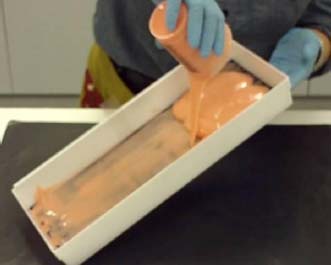
Fig. 2. The remainder of the silicone rubber is poured into the tilted tray.
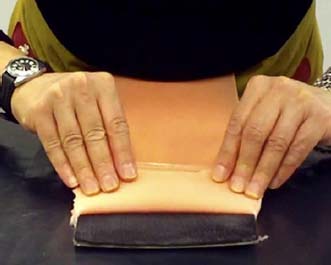
Fig. 3. The silicone mold is peeled away from the leather.
The lifting tabs can be used to pull the panel out of the tray. The silicone mold is peeled away from the leather (fig. 3). It should separate without difficulty. Sticky residues left on the tray can be removed with isopropyl alcohol and paper towels. The cleaned tray and leather panel should be saved and can be reused for additional mold making. The silicone mold can be used immediately and reused many times.
Cast films can be a blend of Golden Heavy Body Acrylic Colors, Heavy Gel Medium, and GAC 200 (either alone or in combinations with GAC 200). Golden has a long track record of collaboration and open dialogue with conservators (Bernstein and Evans 2008). Golden Heavy Body acrylics are widely used in conservation because they include the fewest additives and have high pigment loads (Golden n.d.). They come in both jar and tube, but tubes are preferred for easier measuring. The combination of acrylic paint with the Heavy Gel medium and additives creates a film which captures and holds the surface texture. Gel mediums are available in a range of finishes. The semi-gloss and matte work best to match original leathers and book cloth. GAC 200 and GAC 500 are acrylic polymers that modify the paint/gel properties, increasing film hardness and reducing tack. GAC 200 should not be used along because of concerns that it inhibits flexibility
Reinforcing substrates such as paper, non-woven polyester, or textiles can be embedded into the wet acrylic film during the casting on the mold, or can be adhered later to the dry cast film. Long-fibered kozo papers are the most versatile because they are available in a variety of thicknesses from many suppliers. Suitable textiles such as unbleached, unsized airplane linen or cotton muslin can be used for more robust repairs.
The most useful formulation we use for making cast films is a ratio of one part Golden Artist Colors (GAC) Specialty Acrylic Polymer 500 additive, one part Golden Heavy Gel medium (matte or semi-gloss), and two parts Golden Heavy Body paints color-matched to the original covering material. Other combinations are possible depending on the desired outcome.
The characteristics of each component can be compared (table 4) and if desired the basic formula can be adjusted to customize the result for the intended application. Many formulations of the acrylic components are possible and will work as repairs with subtle differences in the final product. Tips on customization of the formula are included in a later section. Most films created for silicone molds made in Rubbermaid trays required no more than 1 ½ to 2 teaspoons (or about 8-10 mL) for full coverage.
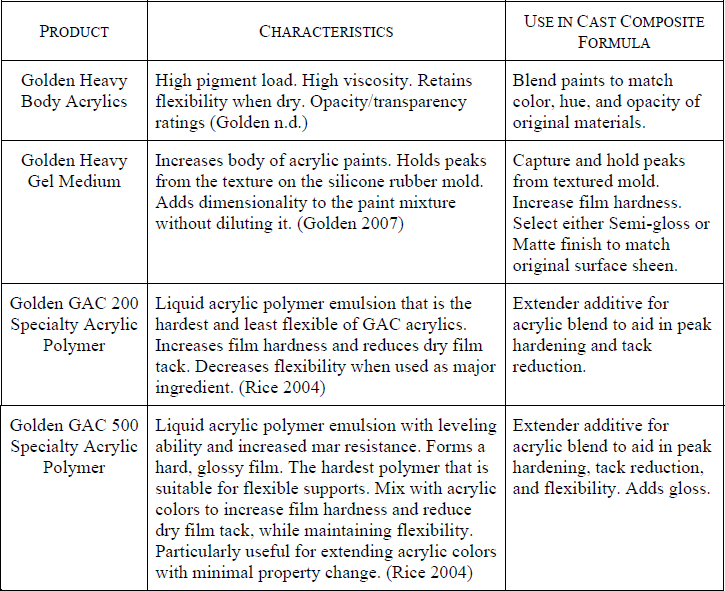
Table 1. Comparative table of acrylic component characteristics. Use as an aid for customizing the formulation.
The custom-mixed paint is added to the selected volume of Heavy Gel medium and GAC 500. A clear container will help to determine that all three components are distributed in a homogeneous mixture. Half of the blend is spread onto the silicone mold with a wide, flexible silicone spatula (fig. 4). Long even sweeps will help to fill all of the depressions in the mold and create a uniform film. The remaining gel mixture should be covered and set aside. This first layer should dry before proceeding. A hair dryer may be used to speed drying time.
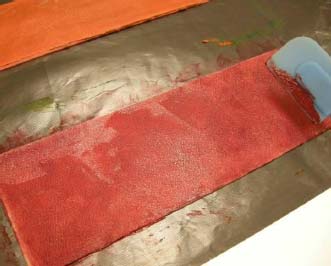
Fig. 4. The acrylic blend is applied to the silicone mold with a wide spatula to create a uniform film.
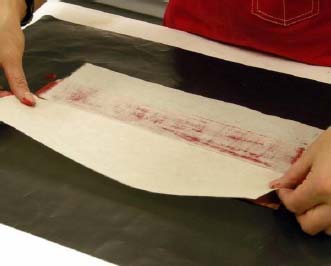
Fig. 5. Japanese paper support substrate is applied to the wet acrylic blend.
The remaining acrylic blend is spread onto the mold with the spatula. At this point in the process there are many options for customization. Further information is presented in the customization section, but the general procedures are presented here. Varying the color and transparency of the layers applied to the mold will produce aesthetically superior repair materials.
The chosen support can be laid onto the second layer. It should be done while the acrylic blend is still wet. The support is dropped onto the surface and pressed into the blend to ensure complete bonding and detail capture without striking through (fig. 5). The blend should partially penetrate, but not saturate, the support. The cast composite (whether film alone or film and support) should dry for 8-10 hours depending on ambient room conditions. If the casting is removed from the mold too soon, its patterned surface may be compromised.
The dried film or composite is removed by placing the mold face down on a work surface, rolling it and peeling the film away from a corner. The material will continue to cure until dried fully for 24 hours or longer before use. The mold can be cleaned with soap and water then towel- or air-dried. Abrasive pads will scratch the surface of the mold.
Incorporating cast composites into standard treatment practice is simple with the preparation of the repair and selection of flexible adhesives. Bound volumes should be cleaned to reduce surface grime. Leather bindings should be consolidated to prepare all surfaces for treatment. The CCAHA “red-rot cocktail” (a 1:1:1 solution of SC6000 acrylic wax emulsion, Klucel G 2% in ethanol, and ethanol) works well (Haines 2002, Brewer 2003).
After replicating the covering material texture on a damaged book (fig. 6) and creating a cast composite, the cast composite is trimmed or torn to the desired dimensions (fig. 7). A needle or scalpel can be used to shape the mend and create irregular edges which help to visually integrate it with the original covering material. Films without a supporting substrate are not strong enough to use in areas of a book that require structural reinforcement. They are better used as cosmetic fills where the original surface layer is lost or abraded.
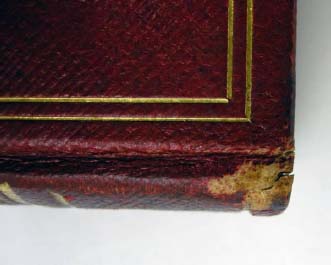
Fig. 6. Sample book, before treatment. Torn and abraded head cap on sample non-collection item.
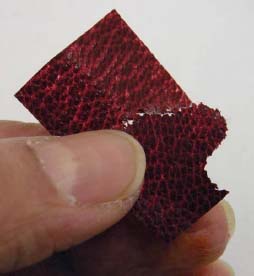
Fig. 7. Cast composite is torn to shape of repair.
Cast composites create less obvious repairs when the support is removed along the edges of the torn repair strip, exposing the cast film (fig. 8). Paring and sanding are two of many techniques to create an extended edge and remove visible fibers on an irregularly shaped fill. Pressure sensitive tape can be used to pull away paper fibers along the edges. A damp swab can be used to push and rub away a narrow margin of the paper substrate on the verso of the cast film. Textiles can be cut and threads pulled from the edges to create a shaggy soft edge. Adhesives used to attach the mend to the book will soften the edge of the cast film after application, allowing it to conform and blend into the surrounding texture on adjacent covering material (fig. 9).

Fig. 8. The verso of a cast composite fill is sanded to expose the cast film along the edge.
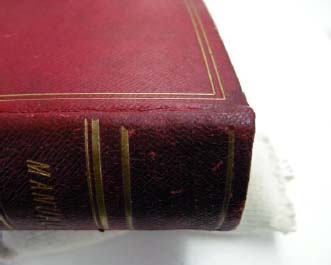
Fig. 9. Sample book, after treatment. Fill adhered to head cap with Lascaux 498HV mixture.
Adhesive selection is crucial to successful repairs with cast composites and should be based on desired repair characteristics. Acrylic adhesives provided the best results. Lascaux 498 HV is used by many conservators to apply solvent-set toned Japanese paper hinge repairs (Anderson & Puglia 2003). Early testing using Lascaux 498HV adhesive, thinned with water, was disappointing. The nature of the cast composite is to slightly rebound after flexing; this caused Lascaux 498HV-adhered mends to pull away from the leather when the cover was opened. Many conservators treating leather use adhesives that remain slightly tacky after drying, such as Rhoplex N-580 and Lascaux 360, prompting concerns about shifting mends, blocking, and adhesive flow. These issues are especially pertinent for books which are often shelved tightly.
A mixture of Lascaux acrylics (1 part Lascaux 360HV, 2 parts Lascaux 498HV, and 2 parts deionized water by volume) worked well as an adhesive for adhering cast composites. Solvents are not recommended for dilution of the adhesives as they can soften the textured surface of the cast film. The Lascaux mixture works best applied in thin layers. The first layer should air-dry, creating a barrier. The second coating of the Lascaux mixture is applied and the cast repair is adhered to the book. Reactivation of the dried adhesive is possible with heat or with an organic solvent (from the verso). Mends immediately conform to the volume and require little weight and pressure to set. Theoretically, these repairs can be removed with solvent if necessary, but the book surface could be altered. No matter how benign the adhesive, the possibility of damage is always present when working with fragile leather.
After selecting and applying the adhesive to the verso, the mend is put in place and dried undisturbed to avoid shifting. Adhesive residues can be cleaned with a damp cotton swab. The head and tail of joint repairs should be turned at a later stage to discourage lifting and shifting. Heat-setting a support onto films can be a fast method of preparing repair materials. Silicone-coated polyester film barriers can gloss the surface of the cast composite repair when using heat to apply a cast composite. Silicone-coated paper can decrease gloss. Other barriers such as nonstick oven liner cut into strips did not seem to alter the finish of the repair.
Utilizing the various components (table 1) it is possible to customize the cast composite to modify color, opacity, sheen, decoration, and support substrates. The most successful combinations for realistic and natural-looking composites for leather and book cloth repairs exploit some aspect of all of these characteristics.
Matching the color saturation and hue of the original covering materials is the most challenging aspect of the cast composite system. The opacity/transparency rating of each acrylic color is crucial. The Golden Opacity/Transparency system, a relative ranking with 1 being most opaque and 8 being most transparent, should be consulted to help guide color selection. Layered application of acrylic blends with high transparency ratings (4 or above) produces aesthetically superior repair materials. Changing the color of a subsequent layer (or layers) of the acrylic blend applied to the mold adds vibrancy, avoiding a flat, “painted’ look. Radical color differences of the layers can add depth to the dry film. Original speckling can be replicated with acrylic paint on a toothbrush, in an aerosol sprayer, or in an airbrush setup. This is most effective when added after a transparent first layer of the wet blend during the casting process.
Subtle shifts in perceived color can also be achieved by toning the substrate before or after the composite has been made. The support can affect brightness; light-colored muslin will produce a repair material that is lighter than dark linen. The color of a repair can be adjusted after it is adhered to the volume with spot application of acrylic paints as a final treatment step.
Every volume will have a unique sheen that may change after consolidation and surface cleaning; assumptions, such as leather is always glossy and cloth is always matte, are not possible. The acrylic polymers tend to be shiny. Products with matte finishes (Heavy Gel Matte medium or Heavy Body Matte acrylic paint) can be substituted to adjust the sheen of the cast repair.
The flat look of patterned book cloth, particularly those of the 19th century, is most successfully replicated by increasing the opacity and decreasing the sheen of the acrylic blend applied to the mold. Combining the matte gel medium and matte acrylic paints will result in the flat, dull look that is characteristic of many book cloths.
The properties of the support substrates can be manipulated by applying them in multiple layers. Multiple supports could provide greater variation with wet or heat-set adhesive application and increased treatment options. Layered supports such as non-woven polyester plus Japanese paper could be used as a modified split-flange board attachment for increased strength (Brock 2001). Non-woven polyesters are trickier to use as a support because they require special adhesive selection. BEVA film is often used by other conservation disciplines for adhering non-woven polyesters.
Cast composites show great promise as a repair material for book conservation treatments. The cast composite system is a low-cost and simple technique that can produce high quality materials that replicate the textures of original coverings. They can be fast and easy to make once the technique is learned. Supplies for the repairs are easy to source and are relatively inexpensive. The system is customizable and opens up a range of techniques for repairing bound materials and matching surface textures.
There are several factors to consider with respect to using the cast composites. The technique should be considered experimental until suitable aging and physical testing can be conducted. Until then, we are reliant on testing carried out to date and product information supplied by the manufacturer. Inherent vice of the object, especially degraded leather, will complicate these issues as it routinely does in book conservation.
The cast composite system can be scaled up or down to fit the needs of special or general collections. Films can be cast in bulk to make a modular system with pre-made films and supports. The time and effort to create cast composites is comparable to similar repair materials like solvent-set tissues. With multiple surrogates and molds, a “library” of textured patterns can be compiled to be readily available for use. Overall, the cast composite system leads to less invasive treatments and more complimentary repair materials for book conservators.
An earlier version of this paper was published in the The Book and Paper Group Annual Volume 29 (2010): 98-105.
The authors would like to thank their colleagues at the Barbara Goldsmith Preservation Division of The New York Public Library; The New York Public Library for the Performing Arts: Jerome Robbins Dance Division; the Library Collections Conservation Discussion Group co-chairs Werner Haun and Jody Beenk; Norman Weiss; Ulysses Jackson at Golden Artist Colors; and Karen Yager for their assistance.
American Institute for Conservation of Historic and Artistic Works. Guidelines for Practice of the American Institute for Conservation of Historic and Artistic Works, “Commentary 23: Compensation for Loss.” Washington, DC: AIC, 2000.
American Institute for Conservation of Historic and Artistic Works – Book and Paper Specialty Group. Paper Conservation Catalog, Chapter 30: Inpainting. Washington, DC: AIC-BPG, 1994.
Anderson, P. and A. Puglia. “Solvent –Set Book Repair Tissue”, The Book and Paper Group Annual Volume 22 (2003): 3-8.
Anderson, P. and S. Reidell. “Adhesive Pre-Coated Repair Materials.” Handout from the Library Collection Conservators Discussion Group. AIC Annual Meeting, Los Angeles, CA. May 2009.
ASTM D 7255-06e1, “Standard Test Method for Abrasion Resistance of Leather (Rotary Platform, Double-Head Method),” in Volume 15.04, Annual Book of ASTM Standards. West Conshohocken, PA: ASTM International, 2006.
Bernstein, J. and D. Evans. “Mastering Inpainting: A Mid-Career Workshop for Conservators” Workshop manual. National Conservation Training Center, Shepherdstown, WV. May 2008.
Brewer, T. “SC6000 and Other Surface Coatings for Leather: Chemical Composition and Effectiveness.” The Cochineal. November 24, 2003. www.ischool.utexas.edu/~cochinea/html-paper/t-brewer-04-sc6000.html (accessed 04/01/10)
Brock, D. “Board reattachment.” Abbey Newsletter Volume 24, Number 6 (2001), p. 97.
Bruckle, I., J. Thornton, K. Nichols, and G. Strickler. “Cyclododecane: technical note on some uses in paper and objects conservation.” Journal of the American Institute for Conservation (JAIC) Volume 38, Number 2 (1999), pp.162-175.
Craft, M. L., and J. A. Solz. “Commercial vinyl and acrylic fill materials.” Journal of the American Institute for Conservation (JAIC) Volume 37, Number 1 (1998), pp.23-34.
Etherington, D. “Japanese paper hinge repair for loose boards on leather books.” Abbey Newsletter, Volume 19, Number 3, Aug 1995. Handout from the ALA Physical Quality and Treatment Discussion Group, June, 1995.
Fredericks, M. “Conference review: Progress in Leather Conservation”. WAAC Newsletter Volume 19, Number 2 (1997).
Gaskell, P. A New Introduction to Bibliography. New Castle, DE: Oak Knoll Press, 1995.
Golden Artist Colors, Inc. “Polymers, Mediums & Additives Reference Guide”. Product catalog and resource guide, 2007.
Golden Artist Colors, Inc. “Product information Sheet: Heavy Body Acrylics”. Technical data and resource guide, n.d. www.goldenpaints.com/technicaldata/hevbod.php (accessed 04/02/10)
Haines, B. M. Surface Coatings for Binding Leathers. Northampton (UK): The Leather Conservation Centre, 2002.
Jones, F. N. “Aspects of longevity of oil and acrylic paints”. Just Paint, Issue 12, November 2004. http://www.goldenpaints.com/justpaint/jp12article1.php (accessed 02/03/10)
Katz, Kenneth B. ”The quantitative testing and comparisons of peel and lap/shear for Lascaux 360 H.V. and BEVA 371.” Journal of the American Institute for Conservation (JAIC) Volume 24, Number 2 (1985), pp. 60-68.
Kite, M., and R. Thomson. Conservation of Leather and Related Materials. Oxford: Elsevier, 2006.
Kronthal, L., J. Levinson, C. Dignard, E. Chao, and J. Down. “BEVA 371 and its use as an adhesive for skin and leather repairs: background and review of treatments.” Journal of the American Institute for Conservation (JAIC) Volume 42, Number 2 (Summer 2003), pp. 341-362.
Nieuwenhuizen, L. “Synthetic fill materials for skin, leather, and furs”. Journal of the American Institute for Conservation(JAIC) Volume 37, Number 1, (1998) pp.135-145.
O’Donnell, A. “Trial materials for creating textured leather fills,” ICOM Ethnographic Conservation Newsletter, Number 16, October 1997.
Primanis, O. “Binding Repairs for Special Collections at the Harry Ransom Humanities Research Center,” The Book and Paper Group Annual Volume 19 (2000): 19-30.
Rice, D. “GAC Specialty Polymers”. Just Paint, Issue 12, November 2004. www.goldenpaints.com/justpaint/jp12article3.php (accessed 02/03/10)
Roberts, M.T. and D. Etherington Entry for “Book cloth” in Bookbinding and the Conservation of Books, A Dictionary of Descriptive Terminology. http://cool.conservation-us.org/don/dt/dt0414.html (accessed 11/24/09)
Sturge, T. “Gilt Leather wall coverings: some options for repair”. Post prints for UKIC conference “Conservation of Decorative Arts”. (1999) pp.65-70.
Sturge, T. The Conservation of Leather Artefacts. Northampton (UK): The Leather Conservation Centre, 2000.
Sturge, T. “Conservation of historic leather,” Syllabus from a training course (Practical Leather Conservation), 2010.
Most supplies discussed in this article are available at common conservation suppliers like Talas (330 Morgan Ave, Brooklyn, NY 11211, http://talasonline.com/) or Conservation Resources (5532 Port Royal Road, Springfield, Virginia 22151, www.conservationresources.com); local art stores or internet retailers (DickBlick Art Materials www.dickblick.com/ or Pearl Art & Craft Supply www.pearlpaint.com/); or local houseware supply stores.
ACRYLIC PAINTS, GEL MEDIA, AND ADDITIVES
Golden Artist Colors, Inc. 188 Bell Road, New Berlin, NY 13411-9527
Heavy Body Acrylic Colors, 2 oz tubes (art supply store)
Heavy Body Matte Colors, 2 oz tubes (art supply store)
Gel Mediums, Heavy (Semi-Gloss) and/or Heavy (Matte), 8 oz jars (art supply store)
GAC 200 Acrylic and GAC 500 Acrylic, 8 oz bottles (art supply store)
ADHESIVES
Lascaux Acrylic Adhesive 360 HV (Talas)
Lascaux Acrylic Adhesive 498 HV (Talas)
OVEN LINER
Betty Crocker Clean Cookin' Oven Liner, 23" x 16.25" (housewares store)
SILICONE MOLD KIT
Rebound® 25 Smooth-On Silicone Rubber (art supply store)
TEXTILES
Airplane linen, 54" wide, 100% linen, 6.33 oz/inch2 (Talas)
Cotton muslin, 44” wide, 100% cotton fabric (Talas)
TRAY
Rubbermaid Drawer Organizer, 15” x 6” x 2” (housewares store)
GRACE OWEN AND SARAH REIDELL
The New York Public Library
Papers presented in Topics in Photographic Preservation, Volume Fourteen have not undergone a formal process of peer review.